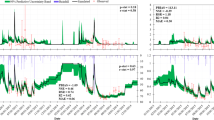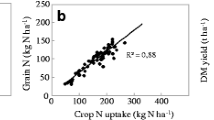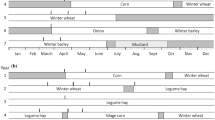Abstract
Soil N2O emissions were measured during four seasons from two highly productive grass-clover dairy pastures to assess the influences of soil moisture, temperature, availability of N (NH +4 and NO –3 ) and soluble C on N2O emissions, and to use the emission data to validate and refine a simulation model (DNDC). The soils at these pasture sites (Karapoti fine sandy loam, and Tokomaru silt loam) differed in texture and drainage characteristics. Emission peaks for N2O coincided with rainfall events and high soil moisture content. Large inherent variations in N2O fluxes were observed throughout the year in both the ungrazed (control) and grazed pastures. Fluxes averaged 4.3 and 5.0 g N2O/ha/day for the two ungrazed sites. The N2O fluxes from the grazed sites were much higher than for the ungrazed sites, averaging 26.4 g N2O/ha/day for the fine sandy loam soil, and 32.0 g N2O/ha/day for the silt loam soil. Our results showed that excretal and fertiliser-N input, and water-filled pore space (WFPS) were the variables that most strongly regulated N2O fluxes. The DNDC model was modified to include the effects of day length on pasture growth, and of excretal-N inputs from grazing animals; the value of the WFPS threshold was also modified. The modified model ‘NZ-DNDC’ simulated effectively most of the WFPS and N2O emission pulses and trends from both the ungrazed and grazed pastures. The modified model fairly reproduced the real variability in underlying processes regulating N2O emissions and could be suitable for simulating N2O emissions from a range of New Zealand grazed pastures. The NZ-DNDC estimates of total yearly emissions of N2O from the grazed and ungrazed sites of both farms were within the uncertainty range of the measured emissions. The measured emissions changed with changes in soil moisture resulting from rainfall and were about 20% higher in the poorly drained silt loam soil than in the well-drained sandy loam soil. The model accounts for these climatic variations in rainfall, and was also able to pick up differences in emissions resulting from differences in soil texture.
Similar content being viewed by others
References
Ball B.C., Horgan G.W., Clayton H. and Parker J.P. 1997. Spatial variability of nitrous oxide fluxes and controlling soil and topographic properties. J. Environ. Qual. 26: 1399–1409.
Bouwman A.F. 1990. Exchange of greenhouse gases between terrestrial ecosystems and atmosphere. In: Bouwman A.F. (ed.), Soils and Greenhouse Effect.Wiley, Chichester, UK, pp. 61–127.
Brown L., Armstrong B.S., Jarvis S.C., Syed B., Goulding K.W.T., Phillips V.R., Sneath R.W. and Pain B.F. 2001. An inventory of nitrous oxide emissions from agriculture in the UK using the IPCC methodology: emission estimates, uncertainty and sensitivity analysis. Atmospheric Environ. 35: 1439–1149.
Brown L., Syed B., Jarvis S.C., Sneath R.W., Phillips V.R., Goulding K.W.T. and Li C. 2002. Development and application of a mechanistic model to estimate emissions of nitrous oxide from UK agriculture. Atmospheric Environ. 36: 917–928.
Butterbach-Bahl K., Stange F., Papen H. and Li C. 2001. Regional inventory of nitric oxide and nitrous oxide emissions for forest soils of Southeast Germany using the biogeochemical model PnET-N-DNDC. J. Geophys. Res. 106: 34155–34165.
Cameron K.C., Kelliher F.M., Sherlock R.R., Forbes E.A., deClein C.A.M. and other members of NzOnet 2000. Nitrous oxide inventory and mitigation. A National Science Strategy Research Programme for New Zealand-A report for MAF-Policy. Centre for Soil and Environmental Quality, Lincoln University, USA, p. 146.
Carran R.A., Theobald P.W. and Evans J.P. 1995. Emission of nitrous oxide from some grazed pasture soils in New Zealand. Austr. J. Soil. Res. 33: 341–352.
Castaldi S. and Smith K.A. 1998. The effect of different N substrates on biological N2O production from forest and agricultural light textured soils. Plant Soil 199: 229–238.
Choudhary M.A., Akramkhanov A. and Saggar S. 2002. Nitrous oxide emissions in New Zealand cropped soils: tillage effects, spatial and seasonal variability. Agric. Ecosyst. Environ. 93: 33–43.
Davidson E.A. 1991. Fluxes of nitrous oxide and nitric oxide from terrestrial ecosystems. In: Rogers J.E. and Whitman W.B. (eds), Microbial Production and Consumption of Greenhouse Gases: Methane, Nitrogen Oxides, and Halo-Methanes. Am. Soc. Microbiol., Washington, DC, USA, pp. 219–235.
Del Grosso S., Parton W., Mosier A., Hartman M.D., Brenner J., Ojima D.S. and Schimel D. 2001. Simulated interaction of carbon dynamics and nitrogen trace gas fluxes using the DAYCENT model. In: Schaffer M., Ma L. and Hansen S. (eds), Modeling Carbon and Nitrogen Dynamics for Soil Management. CRC Press, Boca Raton, FL, USA, pp. 303–332.
Dobbie K.E. and Smith K.A. 2001. The effect of temperature, water-filled pore space, and land use on N2O emissions from an imperfectly drained gleysol. Eur. J. Soil Sci. 52: 667–673.
Dobbie K.E., McTaggart I.P. and Smith K.A. 1999. Nitrous oxide emissions from intensive agricultural systems: variations between crops and seasons, key driving variables, and mean emission factors. J. Geophys. Res. 104: 26891–26899.
Folorunso O.A. and Rolston D.E. 1984. Spatial variability of fieldmeasured denitrification gas fluxes. Soil. Sci. Soc. Am. J. 48: 1214–1219.
Frolking S.E., Mosier A.R., Ojima D.S., Li C., Parton W.J., Potter C.S., Priesack E., Stenger R., Haberbosch C., Dörsch P., Flessa H. and Smith K.A. 1998. Comparison of N2O emissions from soils at three temperate agricultural sites: simulations of year-round measurements by four models. Nutr. Cycling Agroecosyst. 52: 77–105.
Haynes R.J. and Williams P.H. 1993. Nutrient cycling and soil fertility in grazed pasture ecosystems. Adv. Agron. 49: 119–199.
Hedley C., Saggar S. and Dando J. 2002. Use of intact soil cores to assess the effect of soil water content on nitrous oxide emissions from a poorly drained pasture soil. In: Back to the Future, New Zealand Soil Science Society Golden Jubilee Conference, Programme and Abstracts, 25-29 November 2002. Victoria University, Wellington, New Zealand, p. 85.
IPCC (Intergovernmental Panel on Climate Change/Organization for Economic Cooperation and Development) 1997. Guidelines for National Greenhouse Gas Inventories. OECD/OCDE, Paris, France.
IPCC 2001. Technical summary. In: Houghton J.T., Ding Y, Grigg D.J., Noguer M., van der Linden P.J., Dai X., Maskell K. and Johnson C.A. (eds), Climate change 2001: the scientific basis. Contributions of Working Group I of the Intergovernmental Panel on Climete Change. Cambridge University Press, Cambridge, UK.
Ineson P., Coward P.A. and Hartwig U.A. 1998. Soil gas fluxes of N2O, CH4 and CO2 beneath Lolium perenne under elevated CO2: the Swiss free air carbon dioxide enrichment experiment. Plant Soil 198: 89–95.
Kaiser E.A., Kohrs K., Kucke M., Schnug E., Heinemeyer O. and Munch J.C. 1998. Nitrous oxide release from arable soil: importance of N-fertilization, crops and temporal variation. Soil Biol. Biochem. 30: 1553–1563.
Ledgard S.F., Penno J.W. and Sprosen M.S. 1999. Nitrogen inputs and losses from grass/clover pastures grazed by dairy cows, as affected by N fertilizer application. J. Agric. Sci. 132: 215–225.
Li C., Frolking S. and Frolking T.A. 1992a. A model of nitrous oxide evolution from soil driven by rainfall events: 1. Model structure and sensitivity. J. Geophys. Res. 97: 9759–9776.
Li C., Frolking S. and Frolking T.A. 1992b. A model of nitrous oxide evolution from soil driven by rainfall events: 2. Model applications. J. Geophys. Res. 97: 9777–9783.
Li C., Narayanan V. and Harris R. 1996. Model estimates of nitrous oxide emissions from agricultural lands in the United States. Global Biogeochem. Cycles 10: 297–306.
Li C., Zhuang Y., Cao M., Crill P., Dai Z., Frokling S., Moore B., Salas W., Song W. and Wang X. 2001. Comparing a national inventory of N2O emissions from arable lands in China developed with a process-based agroecosystem model to the IPCC methodology. Nutr. Cycling Agroecosyst. 60: 159–175.
MacKenzie A.F., Fan M.X. and Cadrin F. 1998. Nitrous oxide emission in three years as affected by tillage, corn-soybean-alfalfa rotations, and nitrogen fertilization. J. Environ. Qual. 27: 698–703.
Mosier A.R. and Mack L. 1980. Gas chromatographic system for precise, rapid analysis of nitrous oxide. Soil Sci. Soc. Am. J. 44: 1121–1123.
Muller C., Sherlock R.R. and Williams P.H. 1995. Direct field measurements of nitrous oxide emissions from urine-affected and urine-unaffected pasture in Canterbury. In: Currie L.D. and Loganathan P. (eds), Fertiliser Requirements of Grazed Pasture and Filed Crops: Macro and Micronutrients. Occasional Report No. 8. Massey University, Plamerston North, pp. 243–247.
New Zealand Climate Change Project 2002. The National Inventory report, New Zealand Greenhouse Gas Inventory 1990-2000 including common reporting format (CRF) for 2000, April 2002.New Zealand Climate Change Project, Wellington, New Zealand http://www.climatechange.govt.nz).
Oenema O., Velthof G.L., Yamulki S. and Jarvis S.C. 1997. Nitrous oxide emissions from grazed grassland. Soil Use Manage. 13: 288–295.
Parton W.J., Mosier A.R., Ojima D.S., Valentine D.W., Schimel D.S., Weier K. and Kulmala A.E. 1996. Generalised model for N2 and N2O production from nitrification and denitrification. Global Change Biol. 10: 401–412.
Potter C.S., Randerson J.T. and Field C.B. 1993. Terrestrial ecosystem production: a process model based on global satellite and surface data. Global Biogeochem. Cycles 7: 811–841.
Potter C.S., Matson P.A., Vitousek P.M. and Davidson E.A. 1996. Process modeling of controls of nitrogen trace gas emissions from soils Worldwide. J. Geophys. Res.-Atmos. 101: 1361-1377.
Quikchem Methods Manual 2001. Lachet Instruments Division. Zellweger Analytics Inc., Milwaukee, WI, USA.
Robertson G.P. and Tiedje J.M. 1987. Nitrous oxide sources in aerobic soils; nitrification, denitrification and other biological processes. Soil Biol. Biochem. 19: 187–193.
Ruz-Jerez B.E., White R.E. and Ball P.R. 1994. Long-term measurement of denitrification in three contrasting pastures grazed by sheep. Soil Biol. Biochem. 26: 29–39.
Saggar S. 2001. Soil Science at the cross roads-Norman Taylor Memorial Lecture 2001. New Zealand Soil News 49 (6): 132–139.
Saggar S. and Hedley C.B. 2001. Estimating seasonal and annual carbon inputs and root decomposition rates in a temperate pasture following field 14C pulse-labelling. Plant Soil 236: 103–201.
Scotter D.R., Clothier B.E. and Corker R.B. 1979. Soil water in a fragiaqualf. Austr. J. Soil. Res. 17: 443–453.
Sherlock R.R., Johnston G., Kelliher F.M., Newsome P.F. and Walcroft A. 2001. A desktop study of regional variations in nitrous oxide emissions. A report prepared for the Ministry of Agriculture and Forestry. Lincoln University, USA, p. 53.
Smith W.N., Desjardins R.L., Grant B., Li C., Lemke R., Rochette P., Corre M.D. and Pennock D. 2002. Testing the DNDC model using N2O emissions at two experimental sites in Canada. Can. J. Soil Sci. 82: 365–374.
Tate K.R., Scott N.A., Saggar S, Giltrap D.J., Baisden W.T., Newsome P.F., Davis M.R. and Wilde R.H. 2003. Land-use change alters New Zealand's terrestrial carbon budget: reducing uncertainties associated with estimates of soil carbon change. Tellus 55B: 364–367.
Author information
Authors and Affiliations
Rights and permissions
About this article
Cite this article
Saggar, S., Andrew, R., Tate, K. et al. Modelling nitrous oxide emissions from dairy-grazed pastures. Nutrient Cycling in Agroecosystems 68, 243–255 (2004). https://doi.org/10.1023/B:FRES.0000019463.92440.a3
Issue Date:
DOI: https://doi.org/10.1023/B:FRES.0000019463.92440.a3




